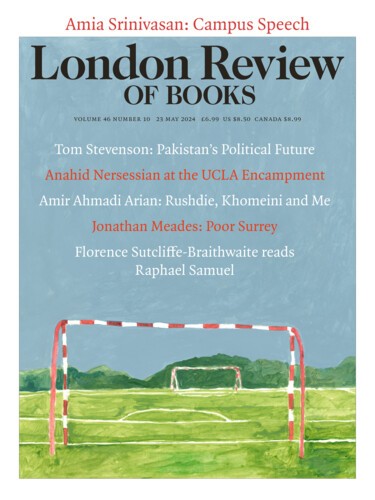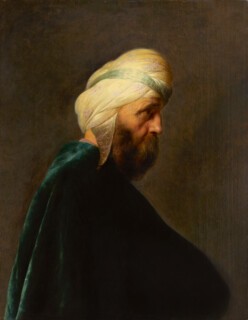Tronies were character studies, popular among 17th-century Dutch and Flemish painters: useful images, painted from life and often recycled in larger works. They weren’t portrait commissions, and as tools for artists they were less bound by convention and the need for flattery. The tronie face might be laughing, crying, whistling, shouting, grinning, gurning. But they were sometimes more than caricatures. Jan Lievens’s Man with a Turban (1629), on display at Turning Heads at the National Gallery of Ireland (until 26 May), is contemplative rather than active.
Lievens was not one for wild expression or extreme physiognomy; his tronies summon a striking human presence. He could render human heads as unforgettable apparitions. In a self-portrait of c.1635, his features are reduced to a wedge-shaped smudge of light emerging from darkness. The Man with a Turban is similarly undone. His green-blue cloak wraps around his body, isolating his swathed head like a rock about to tumble down a steep hill.
Lievens used tricks of scale, luminosity and outline to make his sitters loom large within their frames. He took his cue from the Dutch followers of Caravaggio – the so-called Utrecht Caravaggisti, such as Gerrit van Honthorst and Dirck van Baburen – who lent presence to their figures through dramatic use of light and shade. The turbaned man’s features are painted with great confidence in ochre and lead white and umber, with a tiny streak of cerulean for the vein on his temple – all of it laid down, one imagines, in a single session. By 1629, Lievens had been doing this for some time. Since 1619, when, at the age of twelve, he set up a studio in his family home, he had been celebrated for his great facility with faces. In Man with a Turban, however, it’s the glowing, celestial form of the turban that hits the highest note. Thick strokes of lead pigment conceal almost imperceptible traces of a mauve floral patterning; skeins of light blue, eau de nil and Naples yellow hide in their folds darker greys and browns. The whole is a tightly knotted compound of tonality and luminosity. The strokes of pigment seem themselves to bind the turban tight: they are painted with such confidence that it would be pointless ever to try to paint a turban again. With a final flourish, Lievens appears to spin the brush in his fingers and leave a set of perfectly judged lines in the wet paint of the old man’s beard, like sparks dropping from the pulsating mass above.
Turkish costume, feathered turbans and robes had become popular features of Dutch painting following the Capitulation of 1634 and the opening of new trade routes between Europe and the Ottoman Empire. For a period the ‘Turkse tronie’ was its own specialism. All this must have been exciting to the young Lievens, but the real spur to his ambition was closer to home. Rembrandt was just one year his senior; they had both grown up in Leiden, and in the second half of the 1620s worked so closely (although not necessarily in the same studio, as has sometimes been suggested) that their paintings were for many years considered indistinguishable. What this meant, in practice, was that ‘Lievens’ was subsumed into ‘Rembrandt’, and by the 19th century was almost entirely forgotten. According to the diplomat Constantijn Huygens, who knew them both in Leiden, they were so precocious that even as ‘beardless boys’, to compare them to the best artists of the previous generation would be ‘to underestimate the merits of the two’. In Huygens’s eyes, Lievens was the more remarkable prodigy. ‘Seeing the maker beside his paintings, it is scarcely credible that such a meagre sapling can put forth so much fruit. In painting the human countenance he wreaks miracles.’
Only after the publication in 1897 of Huygens’s autobiography, which includes his short memoir of the two artists, did Lievens start to emerge from Rembrandt’s shadow. German scholars began the work of connoisseurial and philological scrutiny that led to Hans Schneider’s still definitive 1932 monograph, Jan Lievens: Sein Leben und seine Werke. Huygens described in detail Lievens’s overweening ambition and self-confidence; Rembrandt seems, by contrast, a quieter figure. His Bust of an Old Man Wearing a Fur Cap (1630), which hangs close to Man with a Turban in the National Gallery, has the same power but is around a tenth of the size. Rembrandt commands greater psychological depth, drawing forth every bit of humanity from his subjects, and perhaps this owed something to competition with the flashier, pushier Lievens. A portrait of Rembrandt painted by Lievens in c.1628 shows him bright-eyed, diligent. In a self-portrait from the same year, Lievens paints himself wild-haired and wind-blown – an image that might have been painted by Géricault some two hundred years later.
The self-portrait shows the influence of Rubens’s gregarious Flemish manner, but also that of Van Dyck, whom Lievens would have encountered when he went to England around 1632 to work for the court (probably again on the advice of Huygens). The Flemish turn in Lievens’s work during the 1630s has been described as a cooling of his talent, and it’s true that he never quite recaptured the freedom and brilliance of his Leiden years. He achieved the fame he sought, completing commissions for a number of wealthy patrons, not all of them to his credit.
And yet in those few years in Leiden, Lievens equalled – if not surpassed – Rembrandt’s strange greatness. His Portrait of a Young Girl from 1631, painted shortly before he left for England, repeats the side view of the sitter in Man with a Turban. The young girl is lost in thought, her face illuminated by a delicate light, her hair flowing like filaments of white gold, held in place by a diamond-studded red band. Lievens is at his best when concerned with the particular, subtle detail that transforms a work. Here, it is the curling dark mark showing the hole of the girl’s perfectly painted ear, an echo of the small dark arc of her pupil. Just as with Man with a Turban, the painting is less a study of character than an evocation of human presence, not only in the strange light of the hair and the translucency of skin but also, and almost invisibly, the suggestion of her breath through a lightening of pigment around her mouth, exhaled from a warm body in the cold of Lievens’s studio.
Send Letters To:
The Editor
London Review of Books,
28 Little Russell Street
London, WC1A 2HN
letters@lrb.co.uk
Please include name, address, and a telephone number.


